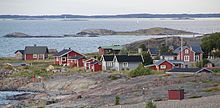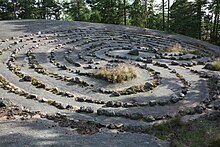Finland Proper (Varsinais-Suomen maakunta, Egentliga Finland) is a region in Western Finland with a population of 480 000. It is the south-west corner of Finland, including much of the archipelago but not the Åland islands.
Regions

- Greater Turku – The Turku metropolitan area is the third biggest in Finland. Here we count it to cover Turku, a few neighbouring towns and some of the countryside to the north.
- Archipelago Sea – The Archipelago Sea is a large archipelago off Turku, reaching the Åland islands in the west and the Gulf of Finland in the east. A maze of thousands of islands and islets.
- Inland of Finland Proper – The inland countryside and the town Loimaa.
- Salo with surroundings – The eastern part of the region. A few towns, partly by the coast.
- Vakka-Suomi – The west coast: the Vakka-Suomi proper and an additional area in the south.
Cities

Cities and towns in blue, rural areas in green.
Greater Turku
The Turku metropolitan area is the third biggest in Finland. The definition here is not the official one.
- 1 Turku (Åbo) – the former capital of Finland, including 2 Raisio (Reso)
- 3 Kaarina (S:t Karins) – residential areas, bird watching, manors and a former bishop's castle
- 4 Naantali (Nådendal) – the Moomin World and wooden old town
- 1 Turku countryside – the countryside north of Turku, including parts of Turku itself, Lieto (Lundo), Masku (Masko), Paattinen (Patis) and Rusko
Archipelago Sea

Current and some former municipalities, their centres and main islands:
- 2 Houtskär
- 3 Iniö
- 4 Kimitoön – countryside and seaside islands
- 5 Korpo
- 6 Merimasku
- 7 Nagu
- 5 Pargas
- 8 Rymättylä
- 9 Velkua
Inland of Finland Proper
- 10 Inland of Finland Proper: Alastaro, Aura, Koski, Marttila (S:t Mårtens), Mellilä, Nousiainen (Nousis), Oripää, Pöytyä (Pöytis), Säkylä, Vahto, Yläne
- 6 Loimaa
Salo with surroundings
Vakka-Suomi

- 10 Uusikaupunki (Nystad) – small coastal town with wooden old town
- 11 Laitila (Letala)
- 12 Vakka-Suomi countryside – the west coast countryside: Askainen (Villnäs), Kustavi (Gustavs), Lemu (Lemo), Mietoinen (Mietois), Mynämäki (Virmo), Pyhäranta, Taivassalo (Tövsala), Vehmaa (Vemo)
Other destinations
National parks
- 1 Archipelago Sea National Park and Archipelago Sea Biosphere Reserve. These cover much of the Archipelago Sea, and are described in that article. Roads (with bridges and ferries) through the main islands, ferry services to many more islands.
- 2 Bothnian Sea National Park starts off Kustavi and Uusikaupunki and continues to the north. Mostly uninhabited outer archipelago, with seals, birds and lighthouses the main attractions. There are some bays with bird watching towers also on the mainland.
- 3 Kurjenrahka National Park and Vaskijärvi Strict Nature Reserve, with raised bogs, mires, lakes and old-growth forest
- 4 Teijo National Park
Islands
The islands listed are all significant tourist destinations, with infrastructure for visitors.
- 1 Bengtskär – skerry with lighthouse by the open sea
- 2 Gullkrona – island with popular guest harbour
- 3 Jurmo – remote barren island with special nature
- 4 Nötö – in the centre of the archipelago south of Nagu
- 5 Själö – lush island with research station and former leper hospital
- 6 Utö – the outermost inhabited island
- 7 Örö – former coastal fort; meadows with rare butterflies, old forests and nice cliffs and beaches
Understand

The name "Finland" was in medieval times applied only to this part of the country, hence the region's present name. This was the gateway for western culture and a central part of medieval Sweden. Turku remained the biggest town in Finland until the late 19th century, long after Helsinki had become capital. Turku is still a one-night cruise away from Stockholm and yachts from Sweden, Helsinki, and Turku are common in the archipelago.
While some people in the archipelago and on the coast still make their livings from the sea, with fishing and seafaring traditions very much alive, inland is more focused on agriculture. The ancient seabed is fertile soil and much of Finland's grain and sugar beet crops are from here, and nowadays greenhouses are abundant. Agriculture is also important in the archipelago, although fields are smaller there.
Talk
The southern coast and the archipelago are mainly Swedish-speaking, while the inland, the western coast and the northern parts of the archipelago are Finnish.
Get in
The area is well connected with the rest of Finland. You can get in by direct trains from Helsinki and Tampere (and sleeping cars from Lapland), however if you are travelling along the Bothnian coast bus should be your transportation of choice. Turku and Naantali have cruise ferry connections with Sweden. Turku airport has flights mainly from Helsinki, Mariehamn and Stockholm, but also regular flights from odd airports in Europe, often including Riga and Gdansk.
Turku is the hub of all connections. You can get off the train in Salo or Loimaa, coaches other than special express ones have stops along the way and minor ferries from Åland have their destinations closer (see Archipelago Sea#Get in), but mostly you need to transfer in Turku – and you probably want to stay there for at least some time, regardless of where you are heading.
Coming with own yacht is reasonably common: along the coast, from Stockholm Archipelago via Åland, directly from Gotland or from Hiiumaa or Haapsalu in Estonia. The outer archipelago is hard to navigate, so you may want to use the main fairways. From the south (the open sea), Mariehamn, Utö and Hanko are the main entry points. See Boating in Finland and Archipelago Sea.
Get around

Trains of VR can be used between Turku, Loimaa and Salo. Revival of regional traffic has been discussed since the 1990s, but as of 2020 plans are still in the blue.
Matkahuolto Reittiopas is a route planner for travelling by bus. The main towns are well connected with coaches, but check timetables in time for minor villages – there may not even be daily services. Also watch out for express coaches not stopping at your stop. If using route planners, note that they sometimes use odd names for the stops and sometimes only know about the main stops (if it is not an express service it will have stops at most a few kilometres apart).
Turku, Raisio, Naantali (including Marimasku, Rymättylä and Velkua), Kaarina, Rusko (including Vahto) and Lieto have common bus tickets (the "Föli" cooperation), valid also on some regional buses, generally any bus with a number (except Onnibus). Thus you can get to some places costing €10 on a coach for €3 on the regional bus. See Turku#By bus.
Many islands in the archipelago have ferry connections, but outside the main routes you may need a boat (or kayak) of your own. There are charter and taxi boat services. See Archipelago Sea.
Bikes are useful for getting around, but to avoid biking along a narrow shoulder or a minor road ending in the wood, some research is needed.
By taxi
Most taxis in Turku use the Taksidata call centre, elsewhere Taksi Länsi-Suomi dominates.
- Taksi Länsi-Suomi
- National smartphone apps: Valopilkku, 02 Taksi, Menevä, Taxi Booker (iTaksi)
See

There are local museums in many of the parish villages, including museum mills, Finnish museum of agriculture in Loimaa, the maritime house in Nagu, and the pulley museum in Iniö. Most sights are found in Turku.
There are several good birding spots. For migrating birds southern islands of the archipelago, such as Utö, Jurmo and Bengtskär are good, as the birds rest or wait for suitable weather there. There are also easy to reach wetlands, such as Järvelä, Kuusistonlahti and Rauvolanlahti in Kaarina.
Other sights include:
- Kultaranta, the Presidential summer residence in Naantali
- Moomin World park for children in Naantali
- The castle and cathedral of Turku
- Paintings from the Finnish Golden Age of Art (and other art) at Turku Art Museum
- Old crafts at the Luostarivuori Handicraft Museum in Turku
- Biotops of Finland with associated stuffed animals in panoramas at Turku Biological Museum
Itineraries

- Archipelago Trail – A 250 or 125 km route around the archipelago, using ferries between the islands. Available by bike, car or coach.
- Hanko-Uusikaupunki by boat – the main leisure fairway through the Archipelago Sea
- Hämeen Härkätie – The old route leading from Turku to Tavastia in the inland. Parts are museum roads.
- King's Road – The road along the south coast since medieval times.
- Kuhankuono trail – A hiking route through the forests and countryside from Turku to Kurjenrahka National Park and farther to near Pyhäjärvi. Part of it is accessible by terrain bike.
- Saint Henry's Way – St. Henry is regarded the national saint of Finland, although not formally recognized by the catholic church. The trail leads through Finland Proper between Köyliö and the cathedral. Groups do part of the trail yearly, all of it every third year.
- Saint Olav Waterway – One of the routes of the Nidaros Path pilgrimage leads to Nidarosdomen in Trondheim from Turku Cathedral, through the archipelago by foot and keel. The route can be used for slow tourism also by non-pilgrims.
Do
Outdooring
- Hike along the Kuhankuono trail network around Kurjenrahka National Park
- Charter a sailing boat or a kayak and explore the Archipelago Sea
Events
- Ruisrock in Turku each July: Finland's oldest rock festival.
- Baltic Jazz in Dalsbruk, Kimitoön: a relaxed music festival annually in July.
- ... – rock, jazz or other music festivals most summer weekends at least somewhere. Few of them are strict with the genre: pop, rock and jazz can be performed side by side
- Classical music festivals – not much of festivals, but a series of concerts, often some of them in places not otherwise used as such venues. Turku, Naantali and Pargas has these, mostly in July–August.
Eat
Drink
Stay safe
Watch out for elk and deer when driving. Roe deer and American white tailed deer are abundant.
Keep warm and afloat when at sea. Be especially careful with children by the shore.
Ticks are common, and can carry Borreliosis or TBE.
If trekking or picking berries in the autumn, have some bright red clothing, as there might be hunters around.
There are bears and wolves, but there have been no reports on them threatening people. You are lucky if you see any trace of them.
There are adders. Keep your distance. If you get bitten, stay calm and call 112 to get advice. The bite should get treatment, although it seldom is dangerous for non-allergic adults. There is also another, non-venomous, snake.
Go next
- Baltic Sea ferries from Turku port to Stockholm in Sweden
- King's Road from Turku via Helsinki to Vyborg in Russia
